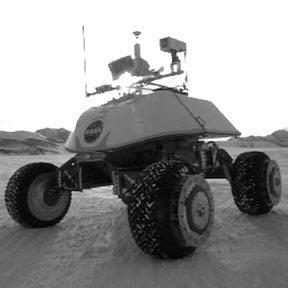
 |
|
|
Field Notes
![]() Nomad
robot finds meteorites
Nomad
robot finds meteorites
 |
Jan. 22 marked the first discovery made by a robot, when an autonomous
robot discovered a meteorite in Antarctica. An expert from the National
Science Foundationís Antarctic Search for Meteorites program deemed
that five of the seven proposed meteorites found by the robot are indeed
real meteorites. The Robotics Institute of Carnegie Mellon University
programmed its robot, Nomad, to search for and identify meteorites on the
Elephant Moraine of Antarctica, an area 160 miles northwest of U.S. McMurdo
Station. Equipped with a high-resolution camera and spectrometer,
Nomad combed an area the size of a football field, determining the composition
of the rocks it encountered. Scientists at Carnegie Mellon programmed
Nomad with enough data to identify common meteorite compositions and assign
a confidence rating before classifying a rock as a meteorite.
Nomad was then able to identify the meteorites in the field in real time.
The Nomad robot (left) from the Robotics
Institute of Carnegie Mellon University.
|
![]() Save
that snow
Save
that snow
The past couple of months have seen heavy precipitation across most
of the United States, largely in the form of snow. The story was
different last summer when the eastern states experienced one of the driest
seasons in history. Moshe Alamaro of the Massachusetts Institute of Technology
believes that making use of abundant winter snowfall is the key to actively
banking water for use during times of drought. Alamaro suggests that
if water droplets are sprayed from altitudes of at least 350 feet on days
when the temperature reaches 0 degrees Celsius, with wind speeds of at
least 1 meter per second and 50 percent humidity, enough snow can be generated
to cover one square meter with 180 kilograms of snow in one day.
A mound of snow could be made and covered with sheets of plastic and air
to insulate the stockpile for up to a year. Removing layers of plastic
during drought could increase the rate of melting and provide water for
the community.
![]() Diamonds
go high-tech
Diamonds
go high-tech
If diamond films on cutting tools and electrical equipment could be made out of a single crystal there would be great advantages for high-voltage, high-temperature electronics and for cutting tools and drills. Todayís coatings are created using many small, aligned crystals because scientists were previously unable to view the earliest stages of diamond crystal formation, when the first tetrahedral carbon structures form. This process, called nucleation, was observed for the first time by a team of scientists in Hong Kong. Shuit-Tong Lee of the City University of Hong Kong observed two diamond crystal seeds as small as 2 nanometers ó only about 2,000 atoms ó on an irregular silicon surface. The claim that one of the seeds grew perfectly aligned with the underlying silicon is supported by research published in the Jan. 7 Science. Controlled growth conditions allowing one aligned seed to grow without interference from competing seeds might produce the single-crystal coatings that scientists are hoping will unleash a diamondís industrial potential.
Laura Wright